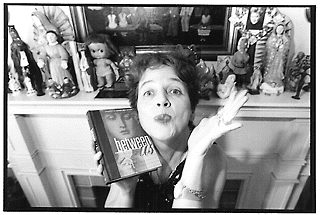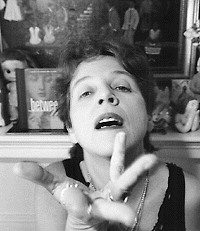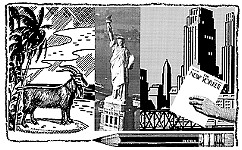Writer/Folklorist Kay TurnerBetween Us
By Robin Bradford, Fri., Jan. 17, 1997
 Kay Turner: Author...Folklorist...Activist...Musician... photograph by Jana Birchum |
Comprising letters from the 1850s -- when postal service became cheap and widely available -- to the present, the collection reveals the urgency, passion, inventiveness, sorrow, and humor of lesbian love in its most personal, written expression. In her expansive introduction, Turner touches on themes invoked by the letters such as the necessity for lesbians to create models for their relationships, the larger frame of women's correspondence, the tenacity of lesbian relationships, and the recurring motifs of cats and religion.
I first became aware of Kay Turner's wacky and intelligent presence in the late 1980s through performances of her band, Girls in the Nose. Singing songs about breasts, pantyhose, and menstrual huts, the band hosted a Madonna Hoot Night at Chances that featured a living buffet of fruit served from a reclining woman's navel. In 1993, Turner's collection of women's dreams about Madonna, I Dream of Madonna, was published in an exquisite volume decorated with witty collages of the Goddess of Pop. More recently, I encountered Turner in an entirely different guise, as a spiritual guide bravely leading a tentful of mourners in their celebration of the life of Austin artist and arts administrator Rita Starpattern.
I interviewed Turner following a successful book tour that took her to the East and West coasts, giving her the opportunity to meet many of the women whose letters she published. She was even offered some "updates" on some particularly thorny love affairs represented in the book. We got together at the Flight Path and over coffee and hot chocolate had this chat.
A.C.: Kay, how do you describe what you do -- your career?
K.T.: I describe myself as an "international lesbian activist folklorist" (laughter). It doesn't necessarily cover everything I do, but the two main places that I come from. I've been doing lesbian and feminist activism for 25 years almost. That's at the root of my personal mission, why I'm on the planet. And folklore has provided me a way to get a certain kind of business done in the arena of lesbianism and feminist activism; to sort of create a basis for recording the expression of that in very common, grassroots terms. I like to refer to it as "unmediated terms," where the dreamlife of someone or the letters that are written between two women are not structured forms of arts -- like fiction or poetry -- their structure comes out of a certain kind of unconscious desire. As a folklorist, I'm interested in seeing just what our unconscious desires are and how they're formulated into traditions and practices that are carried out for the sake of both the individual and the culture.
A.C.: In your introduction to Between Us, you offer a wide-ranging definition of "lesbian" in your introduction: "simply to enjoy and suffer the dramatic experience of loving another . . . woman, of casting one's fate and future with her for however long." Has your inclusiveness ruffled anyone's feathers?
K.T.: Actually, I thought that that definition would come up for more scrutiny than it has. It was my way of trying to introduce a view on lesbianism that was broader and less tied to sexual practice, because a lot of the letters revealed passion and love on a fairly grand scale. The imaginative kind of desire that constitutes these relationships, the way in which the relationships gave rise to a certain kind of freedom of the self and freedom of expression -- even dating back to the 15th or 16th century -- was a commentary on what women found in each other that they didn't find within conventional heterosexual structures. But also very much what they found with each other.... I used that definition because there's a letter from a very young girl in 1944 to another. They came from Zionist Jewish families in New York and met at a Zionist summer camp but they didn't see each other much even though one lived in the Lower East Side and one lived in the Bronx. They never had a sexual relationship, but they loved each other. Both of them did eventually become lesbian, but it's the way in which they both drew on the culture of Judaism (see box) that fascinated me. In this letter, you see the way a 14-year-old in 1944 takes the whole structure of Western civilization, collapsing it for the purpose of what she found with this other girl.
A.C.: The letters occur one after another in the book, decorated with beautiful collages. Brief stories about who wrote them and the circumstances of their writing are in the back. Why did you chose to arrange them like this?
K.T.: I wanted the letters to stand on their own as documents. I also wanted the letters in the book to represent what I had found. There are about 67 pieces in the book and I read almost 6,000. When I was preparing the book I created this map of lesbian culture and history as I discovered it in the letters, so each letter here is emblematic of other letters of its type. That's kind of a folklorist's way of doing things!
A.C.: In your acknowledgments, you mention the importance of lesbian and gay archives as a resource for this book. Tell me about these collections.
K.T.: I drew on two distinct kinds of archives. Ones like the Ransom Center (at UT) and the Beineke (at Yale) are heavily funded, well-managed, and parts of major institutions. If they have one Radclyffe Hall letter, they're going to have 500 (such as the Ransom Center does). The lesbian and gay archives, on the other hand, are still very much grassroots, volunteer-run. They need staffing and funding desperately. So the personal materials there are difficult to get a hold of. They're in boxes that might have someone's name on them. There's no one who's gone through and cataloged them. Working in lesbian and gay archives was strenuous physically, but what really blew my mind was that there were excellent public materials from the post-liberation era --most everything in the archives is post-1969. There is some stuff that precedes that, especially in the Lesbian Herstory Archives (Brooklyn). The amount of public versus private materials in these collections is shocking and I've made this little plea on my book tour. I tell women to go home and to collect their little shoe boxes full of love and don't throw them away or let them get lost, send them off to an archive!
A.C.: I think that when reading love letters between men and women the assumption is that the lovers stay together. One thing that struck me here is that these women don't discount the intensity of the feelings expressed in their letters just because the relationship didn't "work out."
 photograph by Jana Birchum |
A.C.: How was the book tour?
K.T.: It was great. I started in Seattle and did the West coast and then New York and Philadelphia. I was at feminist and straight bookstores. The publisher had said, "Oh, it'll be great if you get 20, 25, 30 people." I was getting 60, 70, 80, 100 in the audience! What was funny was that not only did letter-writers show up but all these people from my past! I read at A Different Light in New York and these women were there I hadn't seen in 25 years. These old friends of mine from college had communicated back and forth between each other for years, and they would say, "You know, some book came out about Madonna. It was written by Kay Turner. Do you think that's our Kay?" They decided to come to the reading to find out if this was "their Kay." So there they were, lined up in the front row. I just started crying, I was really moved.
A.C.: I love both of your books for their physicality: the beautiful collages, the nifty size, the old dime book binding. They're just gorgeous books! Tell me how that came about.
K.T.: I was very lucky with the first book (I Dream of Madonna) because I designed it and sent it to the publisher. A lot of times they want to buy the content but want to send it to their art department. But they bought the whole thing. I told them I wanted it to have this Nancy Drew quality. So we decided to do it for this project, too.
The Madonna book started when I was doing my dissertation on Mexican-American women's home altars in the mid-1980s. I was working with old Mexican-American women and they were telling me all these subversive stories about the Virgin. I was being completely brought into the world of the Blessed Mother. It was very important to me, not just as a scholar, but it was a personal journey, as well. That was when I started dreaming about Madonna. So this Virgin-Madonna thing came together for me in this very odd way. I started collecting the Madonna dreams because it was so odd to me. I had this little file that was called "Madonna & My Dreams" (laughter). I never intended to publish them! But one day I decided to put the dreams together in a little package and sent it to a couple of agents in New York. They loved it but they said: "We're afraid of Madonna, so we can't take this."
Then, Cynthia Rose, a wonderful writer -- she's from Texas but is based in London now -- was doing a book on the Virgin of Guadalupe so she came to Texas to interview various people who'd worked on that material. We met and had a long chat about the Virgin and then at the end of it she said: "Well, what else are you doing?" So I said: "Well, I have this band and I've been collecting these dreams about Madonna. . . ."
A.C.: What are you working on now?
K.T.: A book on women's altars. It's a book that looks at a cross-spectrum--not only Mexican-American but everything from Wiccan to artists to traditional. Also, when I was doing the lesbian love letters book I found some unpublished Gertrude Stein material at the Beineke, love notes that Gertrude had written to Alice at night. I published one of them in the book, but I'm going to do a whole little selected book of them.
A.C.: Where do you hope the future will take you?
K.T.: Well, people will just fall over dead who know me, so you have to put this in there: Kay hopes that she will live in New York at least for a portion of her pathetic life. (laughter) I'm one of those people who came to Austin with no intention of really staying here and now I've been here half my life. I love Austin, but I have this eternal desire to live in the city. I also hope to return to performances in some way. I'm actually thinking of doing a performed version of the love letters because the readings went so well. Orally, they are beautiful. You tend to read the letters individually, but when you hear them, the voices that come out of them mount up. . . . I have gobs of material that is still unpublished and I think it'd be fun for it to take on a life of its own.
Kay Turner will give a reading from Between Us: A Legacy of Lesbian Love Letters at Book People on Friday January 17 at 7pm.
Robin Bradford, a fiction writer, works at the Ransom Center and is a regular contributor to The Austin Chronicle.
Interested readers should contact the Austin Lesbian Activism in the Seventies Herstory Project at 326-5634 for information about archiving personal documents.








